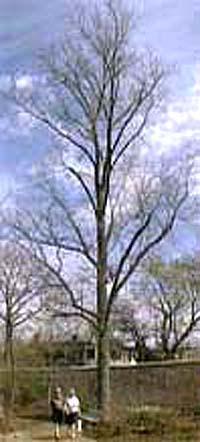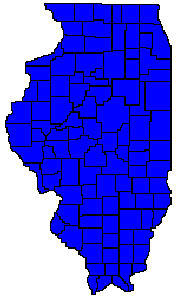 |
| Bitternut Hickory (Carya cordiformis)
Distribution
Map to Right |

Bitternut hickory is also called yellow-bud hickory. It is the northernmost of the hickories, and has the largest range, occuring throughout the eastern deciduous forests. It is present in every county in Illinois. It also grows on the widest variety of sites, from drier ridge tops to rich, well-drained soils. However, it achieves its best growth in mesic forests with good soil. The tree is medium-sized to tall, reaching heights of up to 80 feet, with an oblong crown.
Interesting
Facts
Hickories may be divided into three groups, the pecans, the shagbarks, and the pignuts. Bitternut hickory is in the pecan group, which is distinguishable from the others by its yellow bud scales and its fruits (nuts), which have a four-winged husk. It is the fastest growing hickory and lives for 150 - 200 years. The Latin name "cordiformis" refers to the heart-shaped leaves.
Identifying Features
BarkUses
The bark is brown or gray, becoming furrowed as the tree grows older.
Buds
The terminal buds are distinctive. They are slender, almost an inch long, pointed at the tip, and covered with small, bright yellow dots and fine hairs.
Leaves
The leaves are alternate and pinnately compound with 7 - 9 lance-shaped, finely-toothed leaflets, 6 inches long and 1 1/2 to 2 1/2 inches wide. The upper surface of the leaflets is smooth, shiny, and green and the underside is paler and slightly hairy.
Flowers
Both male and female flowers are born on the same tree, but separately (moneocious). Like the other hickories, flowers appear as drooping catkins in the spring after the leaves start to unfold.
Fruits
The nuts ripen in the fall and have a thin, winged husk that splits at the seams. They are yellowish- brown, round, and approximately 1 inch in diameter. The seeds are very bitter, though squirrels, mice, and deer eat them.
The wood is extremely hard, strong, and close grained. It is used for tool handles, fence posts, and fuel. Native Americans used bitternut hickory as a diuretic and a laxative.